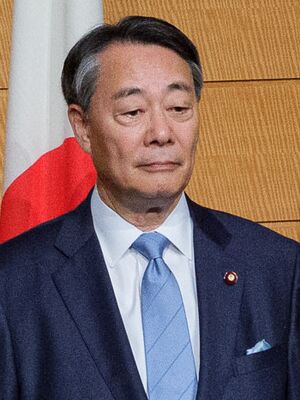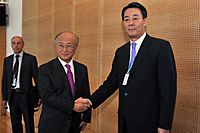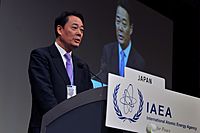Banri Kaieda facts for kids
Quick facts for kids
Banri Kaieda
|
|||||||||||||||||||||||||||||||||||||||||||||||||||||||||
|---|---|---|---|---|---|---|---|---|---|---|---|---|---|---|---|---|---|---|---|---|---|---|---|---|---|---|---|---|---|---|---|---|---|---|---|---|---|---|---|---|---|---|---|---|---|---|---|---|---|---|---|---|---|---|---|---|---|
|
海江田 万里
|
|||||||||||||||||||||||||||||||||||||||||||||||||||||||||

Kaieda in 2023
|
|||||||||||||||||||||||||||||||||||||||||||||||||||||||||
| Vice Speaker of the House of Representatives | |||||||||||||||||||||||||||||||||||||||||||||||||||||||||
| In office 10 November 2021 – 9 October 2024 |
|||||||||||||||||||||||||||||||||||||||||||||||||||||||||
| Monarch | Naruhito | ||||||||||||||||||||||||||||||||||||||||||||||||||||||||
| Speaker | Hiroyuki Hosoda Fukushiro Nukaga |
||||||||||||||||||||||||||||||||||||||||||||||||||||||||
| Preceded by | Hirotaka Akamatsu | ||||||||||||||||||||||||||||||||||||||||||||||||||||||||
| Succeeded by | Kōichirō Genba | ||||||||||||||||||||||||||||||||||||||||||||||||||||||||
| President of the Democratic Party of Japan | |||||||||||||||||||||||||||||||||||||||||||||||||||||||||
| In office 25 December 2012 – 14 December 2014 |
|||||||||||||||||||||||||||||||||||||||||||||||||||||||||
| Preceded by | Yoshihiko Noda | ||||||||||||||||||||||||||||||||||||||||||||||||||||||||
| Succeeded by | Katsuya Okada | ||||||||||||||||||||||||||||||||||||||||||||||||||||||||
| Ministry of Economy, Trade and Industry | |||||||||||||||||||||||||||||||||||||||||||||||||||||||||
| In office 14 January 2011 – 2 September 2011 |
|||||||||||||||||||||||||||||||||||||||||||||||||||||||||
| Prime Minister | Naoto Kan | ||||||||||||||||||||||||||||||||||||||||||||||||||||||||
| Preceded by | Akihiro Ohata | ||||||||||||||||||||||||||||||||||||||||||||||||||||||||
| Succeeded by | Yoshio Hachiro | ||||||||||||||||||||||||||||||||||||||||||||||||||||||||
|
|||||||||||||||||||||||||||||||||||||||||||||||||||||||||
| Personal details | |||||||||||||||||||||||||||||||||||||||||||||||||||||||||
| Born | 26 February 1949 Tokyo, Japan |
||||||||||||||||||||||||||||||||||||||||||||||||||||||||
| Political party | CDP | ||||||||||||||||||||||||||||||||||||||||||||||||||||||||
| Other political affiliations |
JNP (1992–1994) DP 1996 (1996–1998) DPJ (1998–2016) DP 2016 (2016–2017) |
||||||||||||||||||||||||||||||||||||||||||||||||||||||||
| Alma mater | Keio University | ||||||||||||||||||||||||||||||||||||||||||||||||||||||||
| Signature | |||||||||||||||||||||||||||||||||||||||||||||||||||||||||
| Website | Official website: http://kaiedabanri.jp/ | ||||||||||||||||||||||||||||||||||||||||||||||||||||||||
Banri Kaieda (海江田 万里, Kaieda Banri, born 26 February 1949) is a Japanese politician. He has been the Vice Speaker of the House of Representatives of Japan since 2021. He is a member of the House of Representatives of Japan, which is like one of the main parts of Japan's parliament. From 2012 to 2014, he was also the leader of the Democratic Party of Japan. He used to be a minister in the government led by Prime Minister Naoto Kan.
Contents
Early Life and Education
Banri Kaieda was born and grew up in Suginami, a part of Tokyo, Japan. His father was a newspaper reporter who wrote about China and Taiwan. Because of this, Banri was named after the Great Wall of China, which is called "Banri no Chōjō" in Japanese.
He went to Keio University, where he studied political science. He also learned English, German, and Chinese. Before becoming a politician, he was known as a television personality. In the late 1980s and early 1990s, he appeared on TV. He had roles in comedy shows and also worked as a serious news anchor. He hosted a Saturday evening news program on TV Tokyo from 1989 to 1991.
Political Journey
Before he was elected, Kaieda worked as an economic expert. He also served as a secretary for a member of the House of Councillors. This is another part of Japan's parliament.
Starting in the House of Representatives
In 1993, Banri Kaieda won his first election to the House of Representatives. He was first a member of the Japan New Party. After this party ended, he helped start the Democratic Party of Japan in 1996.
In the 1996 election, he lost his local seat in Tokyo. However, he still kept a seat through a special system called "proportional representation." He won his local seat back in the 2000 and 2003 elections. But in the 2005 election, he lost both his local seat and his proportional representation seat. This meant he was out of the House of Representatives for a short time.
Role in the DPJ Government

In the 2009 general election, Kaieda won his Tokyo local seat again. This election was important because the Democratic Party of Japan (DPJ) won enough seats to form the government.
In September 2010, Kaieda became the Minister of State for Economic and Fiscal Policy. In this role, he encouraged the Bank of Japan to buy foreign money. This was done to stop the Japanese yen from becoming too strong.
In January 2011, Prime Minister Naoto Kan chose Kaieda to lead the Ministry of Economy, Trade and Industry. A big event happened in March 2011: the Fukushima disaster. After this, some problems within the ministry became clear. Kaieda decided to step down as economy minister in August to take responsibility.
After Prime Minister Kan resigned in August 2011, Kaieda tried to become the next leader. He lost to Yoshihiko Noda in a vote.
In the 2012 election, the DPJ lost many seats. Kaieda lost his local seat but kept a seat through proportional representation.
Leading the Opposition Party
After the 2012 election, the DPJ leader, Yoshihiko Noda, resigned. Banri Kaieda was then elected as the new president of the DPJ on December 25, 2012. He won against Sumio Mabuchi.
In the 2013 election for the House of Councillors, the DPJ faced another defeat. Despite this, Kaieda continued to lead the party.
In the 2014 election, Kaieda lost his local seat again. He then resigned as the leader of the DPJ. Katsuya Okada took over as the party president.
Joining the Constitutional Democratic Party
In 2017, Banri Kaieda joined a new party called the Constitutional Democratic Party of Japan. This happened after the previous Democratic Party split up.
In the 2017 general election, he won his Tokyo local seat back after a close race. In the 2021 general election, he lost his local seat but was able to keep a seat through proportional representation. He was reelected in the 2024 general election.
See also
 In Spanish: Banri Kaieda para niños
In Spanish: Banri Kaieda para niños


